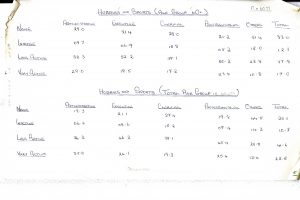From 1969 onwards, the questionnaire tried to more accurately capture the physical activity of the civil servants beyond the confines of work by asking them how they would describe their walking speed and secondly whether they had any hobbies or participated in sports. Research began to show that there was a correlation between lower death rates and incidence of cardiovascular disease and having a more physically demanding job. The answers listed for hobbies and sport were graded on the perceived level of activity e.g. swimming and other sports were high level; DIY and jobs around home moderate whilst sedentary activities like model making and music were low. From these results, investigators showed that more physical activity meant less risk of coronary heart disease and other potentially fatal conditions. While these results have been undoubtedly useful to epidemiologists, they also provide us with a record of the social lives of London based civil servants in the 1960s.
From the 9200 completed questionnaires including this question, I have surveyed 500 to create a sample list of the types of activities that Whitehall Study volunteers were undertaking.
[table id=1 /]
As you can tell from the table, the number one pastime of the [male] Civil Service was gardening. According to the Office of National Statistics in a 2010 survey, gardening still rated highly as one of the main leisure activities conducted in the country, especially with those aged 45-64 (62%). This was followed by the other familiar stalwart of the UK family home, DIY. DIY and interior decorating had a relative boom after the Second World War and was popularised by TV programmes such as Barry Bucknell’s Do It Yourself.
The next four places go to active hobbies or sports, namely walking, swimming, golf and tennis. Racket sports and individual sports tended to rate higher than team sports such as cricket, football and rugby which is unsurprising considering the age of the participants (some volunteers noted their past activities or mentioned that they were now mostly involved with refereeing or coaching).
The next highest placed entry was motoring. Motoring activities including motorbike riding, racing and car maintenance and was far more common entry than sailing activities. Car ownership was relatively high in the Whitehall Study cohort, with one study showing a figure to be 72%.
The remainder of the list shows a juggling of sedentary hobbies such as photography, model making and reading with other active hobbies such as badminton, dancing and fishing [or semi-active in this case]. Sedentary hobbies were probably more prevalent than the list suggests as some participants were likely to not think them relevant for a health survey or not wish to disclose them. What is interesting in these samples is to see some of the trends of hobbies which are now marginal or archaic. Radio making and sound recordings occurred a number of times, along with dingy sailing, and breeding show canaries. There are also occasionally very personal responses or activities listed such as one participant mentioning he wrote novels (and turned out to be a prolific author); another being the heartwarming response that he took ‘blind people on tandem bike rides’ and finally, the man who decided just to put ‘sex’!
The Whitehall survey questionnaires provide a partial insight into the inner world of civil servants of this period, and although the main conclusions from my brief survey are hardly surprising (civil servants enjoy gardening and golf, who knew?) they can sometimes delight in the details they reveal. I end with a video from 1957 showing an exhibition on doctors’ hobbies, just to show that the civil servants did not have a monopoly on male leisure activities!





